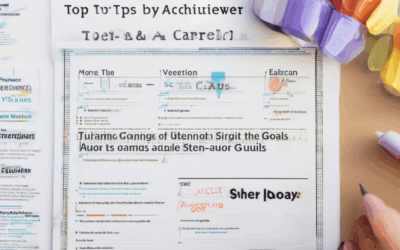In today’s fast-paced world, achieving a healthy work-life balance has become more challenging than ever. With demanding jobs, never-ending tasks, and constant connectivity, many professionals struggle to find harmony between their career and personal life. Work-life balance isn’t just about having downtime—it’s about recharging, staying productive, and enjoying life outside of work. This article explores practical strategies to create a balanced schedule, understand the importance of setting boundaries, and discover how to implement sustainable practices that benefit both your professional and personal life. Whether you’re seeking ways to prioritize self-care or looking to optimize your productivity, this guide offers actionable insights to help you craft a perfect schedule that aligns with your goals and ensures long-term success.

Creating a Work-Life Balance
To achieve a successful work-life balance, consider the following structured approach:
- Understand Your Priorities : Begin by identifying what is most important in both your professional and personal life. Create lists to differentiate between urgent/critical tasks and those that can be deferred.
- Effective Time Management : Utilize tools like calendars or planners to organize your schedule. Allocate specific blocks of time for work and reserve others for personal activities, ensuring a structured yet flexible routine.
- Set Boundaries : Establish clear limits on work-related activities, such as designated hours for checking emails or responding to messages. This helps prevent work from encroaching on personal time.
- Prioritize Health : Incorporate regular exercise, sufficient sleep, and a balanced diet into your routine. These habits contribute to overall well-being and can be integrated into a busy schedule with careful planning.
- Practice Mindfulness : Engage in daily meditation or deep breathing exercises for stress reduction. Start with simple techniques found online to develop a consistent practice.
- Seek Support Networks : Share your goals with supportive individuals or join groups/mentors who have successfully managed their work-life balance. This provides motivation and practical advice.
- Reflect and Adjust : Regularly evaluate your approach. What works for others may not suit your unique situation. Stay flexible and open to modifying strategies as needed.
- Consider Professional Help : If challenges persist, seek therapy for personalized strategies. There’s no shame in seeking assistance for improved well-being.
By focusing on these elements, you can cultivate a balanced life that offers both professional success and personal fulfillment.
What is the 888 rule for work-life balance?
The 888 rule is a simple yet effective strategy for achieving better work-life balance. It involves dividing your day into three equal parts, each lasting approximately 8 hours:
- Work:** Dedicate 8 hours to your professional responsibilities. Use this time to focus on tasks that bring value to your job and set clear boundaries to avoid work-related stress outside of work hours.
- Sleep:** Allocate 8 hours for rest and rejuvenation. Prioritize quality sleep to ensure your body and mind function optimally the next day. Aim for 7-9 hours of sleep each night for optimal health benefits.
- Personal Time:** Reserve the remaining 8 hours for activities you enjoy. This could include hobbies, spending time with loved ones, exercise, or any other relaxing activities that contribute to your well-being.
This approach helps create a balanced routine that supports both your professional and personal life. By dedicating specific time blocks to each area, you can reduce stress, improve productivity, and enhance overall happiness.
For more tips on mastering work-life balance, explore our guide to achieving a harmonious lifestyle .

How to Achieve a Better Work-Life Balance
To enhance your work-life balance, consider the following organized approach:
- Understand Your Priorities : Begin by identifying what truly matters in your life. Create a list of personal and professional goals to guide your decisions.
- Effective Time Management : Utilize tools like the Eisenhower Matrix to categorize tasks by urgency and importance. Focus on high-priority activities and delegate or eliminate less critical tasks.
- Set Clear Boundaries : Establish specific work hours and communicate these to your employer. Avoid checking emails outside these hours to protect your personal time.
- Practice Mindfulness : Incorporate daily mindfulness practices such as meditation or deep breathing exercises. Take short walks during breaks to refresh your mind.
- Prioritize Health : Engage in regular physical activity, aiming for at least 30 minutes of exercise daily. Ensure adequate sleep by maintaining a consistent bedtime routine.
- Nurture Relationships : Schedule regular social time with loved ones and join clubs or groups that align with your interests to build a supportive community.
- Reflect and Adjust : Keep a journal to monitor your activities and emotions. This tool can help identify areas for improvement and track your progress.
- Seek Professional Help if Needed : Don’t hesitate to consult a therapist if you find managing work and life challenging. Professional guidance can offer personalized strategies.
By integrating these strategies, you can work towards a more balanced and fulfilling life.

What is an Unhealthy Work-Life Balance?
An unhealthy work-life balance occurs when a person prioritizes work over their personal well-being, leading to chronic stress, burnout, and neglect of essential aspects of daily life such as family, friends, hobbies, and self-care. This imbalance often results in physical and mental health issues, decreased productivity, and strained relationships.
Signs of an Unhealthy Work-Life Balance
- Overwork: Consistently working long hours without downtime.
- Stress and Fatigue: Feeling overwhelmed and exhausted most of the time.
- Lack of Interest: Losing passion for work or life activities.
- Health Issues: Frequent headaches, sleep problems, or other physical symptoms.
- Relationship Strain: Neglecting family and friends due to work commitments.
Effects of an Unhealthy Work-Life Balance
- Physical Health: Prolonged stress can lead to high blood pressure, heart disease, and weakened immunity.
- Mental Health: Burnout increases the risk of anxiety, depression, and cognitive decline.
- Productivity Plummets: Overworking often leads to lower efficiency and creativity.
- Social Isolation: Limited time for social activities can strain relationships and lead to loneliness.
Causes of an Unhealthy Work-Life Balance
- Excessive Expectations: Setting unrealistic goals and deadlines.
- Poor Time Management: Inefficient habits leading to constant work commitment.
- Lack of Boundaries: Failing to establish work and personal time separation.
- Cultural Pressures: Job market demands that prioritize work above all else.
Consequences of Poor Work-Life Balance
- Increased healthcare costs due to preventable conditions.
- Reduced job satisfaction and motivation.
- Higher turnover rates in the workforce.
- A culture of stress and burnout in organizations.
Solutions to Achieve Better Work-Life Balance
- Set Clear Boundaries: Establish work hours and commit to non-work activities.
- Practice Self-Care: Engage in hobbies, exercise, and adequate sleep.
- Time Management Techniques: Prioritize tasks and delegate responsibilities.
- Seek Support: Talk to a professional if burnout becomes overwhelming.
- Stay Connected: Maintain relationships through regular communication.
By addressing these areas, individuals can create a healthier work-life balance, leading to improved well-being and professional success. For more insights and actionable strategies, explore our guides on time management and stress reduction .
Best Work Schedule for Achieving Work-Life Balance
Creating a work schedule that promotes work-life balance involves strategic planning to ensure you’re neither overworked nor underproductive. Here’s a structured approach to designing an optimal schedule:
- Set Clear Boundaries – Establish fixed working hours to demarcate work from personal time. This helps prevent work-related stress from spilling into your personal life and vice versa.
- Adopt a Flexible Schedule – If your role allows, consider a 4-day workweek. This approach typically involves working four 10-hour days, allowing for three days off, which can significantly enhance your ability to recharge.
- Time Blocking – Allocate specific blocks of time for work and leisure activities. This method ensures that you dedicate focused energy to tasks without overlapping personal commitments.
- Apply the 80/20 Rule – Dedicate 80% of your workday to high-priority tasks and take regular breaks (the remaining 20%). This strategy maintains productivity while preventing burnout.
- Embrace Flexibility – Leverage remote work options if available. This flexibility allows you to manage your schedule more effectively and communicate your availability clearly to coworkers.
- Prioritize Tasks – Use tools like the Eisenhower Matrix to differentiate between urgent and important tasks. This helps in managing your time more efficiently and reducing unnecessary stress.
- Regular Breaks – Incorporate short breaks throughout your workday. Activities like a quick walk or a brief meditation session can rejuvenate your mind and improve focus.
- Limit Distractions – Utilize apps or settings to minimize work-related interruptions. This allows you to stay present and maximize your productivity during work hours.
- Ensure Adequate Sleep – Prioritize sleep to support both physical and mental well-being. A well-rested body and mind are essential for sustained productivity and balance.
- Seek Support – Don’t hesitate to reach out to colleagues or mentors for advice. Professional networks can offer valuable insights and strategies for maintaining equilibrium.
By thoughtfully integrating these elements into your schedule, you can create a balanced and sustainable routine that enhances both your professional success and personal fulfillment.

Why Do People Struggle with Work-Life Balance?
Work-life balance refers to the equilibrium between professional responsibilities and personal well-being. Despite its importance, many individuals face significant challenges in achieving this balance. Below are the primary reasons:
- Excessive Work Pressure: High-pressure environments, tight deadlines, and long working hours can leave individuals feeling drained, making it difficult to unwind and spend quality time with loved ones.
- Poor Time Management: Inadequate planning and prioritization can lead to overcommitment, causing individuals to overlook personal responsibilities and leisure activities.
- Constant Connectivity: The ubiquity of digital devices ensures that work intrudes on personal time, making it hard to fully disconnect and relax.
- Demanding Job Sectors: Industries like healthcare and emergency services often require round-the-clock attention, complicating efforts to maintain a traditional work-life balance.
- Cultural Norms: A culture that prioritizes work above all else can discourage individuals from taking necessary downtime, fostering an environment where personal well-being is neglected.
- Financial Constraints: Financial pressures may necessitate additional work hours or side jobs, leaving little time for personal activities and hobbies.
- Lack of Employer Support: Inflexible working hours, inadequate parental leave policies, and limited flexibility can hinder individuals’ ability to manage their personal lives effectively.
- Social Expectations: Feelings of obligation to always be available for social events or to meet others’ expectations can add pressure to maintain an unrealistic balance.
- Mental Health Challenges: Work-related stress and burnout can negatively impact both professional performance and personal well-being, creating a vicious cycle of imbalance.
Addressing these challenges requires a multifaceted approach, including improved workplace policies, better time management strategies, and a cultural shift toward valuing personal well-being. By understanding these factors, individuals and organizations can work collaboratively to foster a healthier work-life balance, ultimately leading to greater job satisfaction and personal fulfillment.




0 Comments